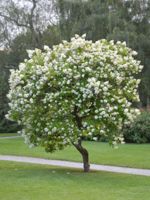Mon-Fri 9am - 5pm Mountain time
Japanese Tree Lilac vs Manchurian Apricot
Syringa reticulata
Prunus armeniaca var. mandshurica
NOT AVAILABLE THIS SEASON - MIGHT RETURN
Japanese Tree Lilac is an attractive, heavy-flowering lilac with fragrant white blossoms. It can be pruned to a single stem or grown as a multi-stemmed shrub.
Japanese Tree Lilac's dark reddish-brown bark peels as the tree ages, creating visual appeal for any yard, especially in the winter.
This tree is often planted along boulevards and its attractive white flowers signal spring to all who drive by.
Manchurian Apricot is a winter-hardy relative of the native plum. This tree can stand some drought, but will not handle standing water or saturated moist soils. It can be used in shelterbelts, hedges, or as an ornamental. Manchurian Apricot will also attract songbirds, rabbits, and other rodents if left uncontrolled.
This tree will produce fruit once it reaches maturity at between two and five years old. Other famous cultivars of Manchurian Apricot include Scout Apricot, Moongold, and many more.
Japanese Tree Lilac Quick Facts
Manchurian Apricot Quick Facts
In row spacing: 0.9 m (3 ft)

